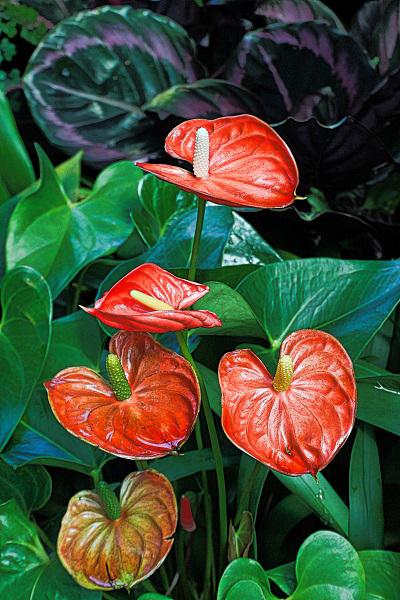Latin name: Anthurium sp.Family: Araceae
Anthurium is one of the hardiest houseplants, and their beautiful color adorns our room or office.
Light – Position – Temperature
Anthuriums need bright light, but if it is to be placed near a window, then you need to make sure it is out of the sun and out of drafts. The temperature should be between 18 and 21 degrees Celsius, and sudden temperature changes should be avoided, especially in the evening hours. They are tropical plants so they like humidity and sufficient temperature. In Anthuriums it is not forbidden to wet the leaves, but we can use a sprayer to wet the mature – never the young – leaves of our plant, or to clean the dust off with a soft and wet sponge. Watering – Fertilization
Water the plant frequently during the flowering and growing period in the summer months. However, in winter, it needs less water, which does not mean that the soil should be left to dry out completely, but neither does the opposite of overwatering, because then you will be wilting your plant. As far as fertilization is concerned, during the period of its growth, we give our plant liquid fertilizer once a week. The frequency of fertilisation should be reduced at the beginning of winter, and stopped completely during the period of stagnation of the plant’s growth, i.e. the winter months.
Enemies and Diseases
By monitoring the Anthurium we can easily read any symptoms that may be due to disease, or over- or even under-watering.
α) Yellowing of the leaves from the edge inwards. It is an indication of excessive watering and a temperature lower than required. Allow the plant to dry out, and move it to a warmer position.
b) Brown spots. This means the presence of a fungus. You should immediately cut off the affected leaves and spray with a suitable fungicide for fungi.
c) Wilted flower. The flowers of all plants, when they come full circle, wither and fall off. However, there is one more case to consider. It is none other than the presence of the botrytis. Botrytis occurs in conditions that combine the presence of moisture and cold. Anthuriums love humidity, but hate the cold. If botrytis occurs, control with the appropriate insecticide.

